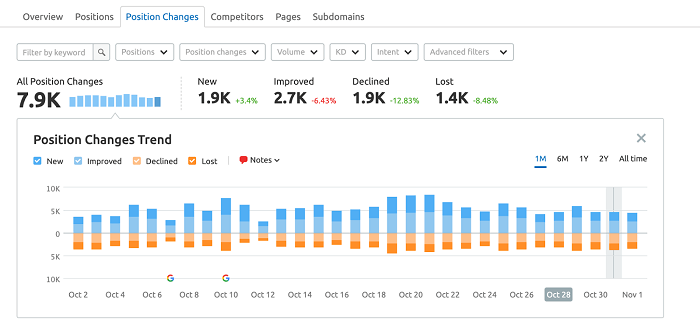How to Use Semrush for Keyword ResearchSemrush is a well-known online marketing tool that digital marketers, writers, and SEO experts use to improve the functionality of their websites and raise their online presence. Users can extract keywords, examine website traffic, manage social media campaigns, and monitor their rivals' moves with Semrush. 
What is Keyword Research?A crucial component of SEO and content production is keyword research. It entails figuring out the key phrases and terms that people most frequently use to search for information or answers to their problems. You may improve your website's visibility in search engine results pages and get more relevant traffic to your site by choosing and utilizing the appropriate keywords in your content. Users who conduct keyword research with Semrush gain insightful knowledge about the search habits of their target market, including the most common search terms, related keywords, search volume and other metrics. Users may improve their chances of ranking higher in search engine results pages and bringing more organic traffic to their website by analyzing this data and selecting the most pertinent and profitable keywords to target in their content. How to log in to Semrush and where to find the keyword research tool?You must sign into your Semrush account to utilize the keyword research tool. This is how you do it:
The process of logging into Semrush and using the keyword research tool is simple. You may choose the most effective keywords in your content and improve your chances of appearing higher in search engine results pages by using Semrush's keyword research tool. Why should you conduct Keyword Research frequently?The generation of content and search engine optimization (SEO) both depend on keyword research. It entails figuring out the key phrases and terms people use to search for information or answer their problems using web search engines. Regularly conducting keyword research has the following advantages, among others:
What are the fundamentals of Semrush's keyword research?To find high-performing keywords and optimize their content for search engines, digital marketers and SEO experts most frequently use this well-known keyword research tool called Semrush. The following are some fundamental procedures for carrying out keyword research in Semrush:
Doing Keyword Research based on CompetitorsAnother strategy is competitor-based keyword research, which starts with websites that are already listed in the SERP. For this approach, you typically gather seed websites to begin the investigation rather than seed keywords. Here's how to proceed: Step 1: Discover Your Organic Competitors through Organic ResearchWith the use of organic research, you can locate your rivals in organic search, check the terms they rank for, and look at the recent fluctuations in their page rankings. Start by visiting Organic Research, typing your domain address into the search box within the 'Competitors' section, and scrolling down to the table after the search has been completed. You will own a list of your rivals; they may be now used as your seed domains. The list is ordered by "Competition Level", which measures how closely a website is a competitor to the one you entered. This statistic is also displayed based on "Competition Level", which measures the total number of keywords a competitor is ranked for and the proportion of keywords the competitor shares with the provided website. You must sort the domain list according to the degree of competition or the number of common keywords. To reassemble the report for the website, you may click the domain name or the arrow icon to open it in a new tab. Step 2: Extract the Keywords of your competitorsThe 'Positions' report of the 'Organic Research' for your seed domain is the next destination. Here, you can view all the search terms for which a specific domain is included within the top 100 results. The URL of the associated landing page and other metrics are provided with each term a domain ranks for to help you with your study. By selecting the 'Advanced Filters' button, you can add filtering options to shortlist specific keywords from the likely too-long list you will receive. For instance, we can locate keywords that contain the phrase "cat food" and have a KD lower than 60. To obtain the most pertinent data, you should experiment with various combinations of additional filtering choices. If you try adding other filtering options, you might uncover some keywords that are profitable. Step 3: Discover Chances & Optimize ContentFinding possible quick chances is now simple; all you have to do is to create a list of filtered keywords and start working on them. Additionally, you may keep a check on your competitor's ranking fluctuations to find opportunities for ranking potentials. Look at the listings of Lost and Declined keywords in the 'Position Changes' tab.
Since the competitor lacks these keywords to rank for, you can create better content for such keywords and optimize them by following SEO practices. In this way, you can beat your competitors. 
Keyword Gap Tool: What is it?Semrush's Keyword Gap tool is another great feature that can assist you in finding keywords for which your rivals are currently ranking, but you are not. With the aid of this tool, you may identify any loopholes in your content strategy and discover fresh ways to raise your website's online presence and draw in more relevant visitors. Here are some steps to use the Keyword Gap tool in Semrush:
Finding Keywords using Topic ResearchSome people may argue that good content is simply a key to digital success, which is somewhat accurate, but we cannot ignore better content marketing approaches and SEO practices in today's competitive market. The ability to have all together can greatly affect one's success. While content marketing is more general and focuses more on messaging, email marketing and communication, SEO can be more focused towards technical things. Finding out what your audience is interested in and/ or what's trending is the essence of keyword research for preparing good content before content marketing and SEO may take place. The tool named Topic Research may be beneficial for this purpose. Topic ResearchSemrush's Topic Research tool fully lets you find pertinent topics and article ideas for your website or blog. The Topic Research tool may help you develop content that resonates with your audience by giving you insights into the themes they have well-liked by analyzing the top-performing material in your sector. The tool provides a comprehensive list of subtopics, headlines, and questions pertinent to your chosen topic, enabling you to produce exciting and educational content that drives targeted traffic to your website. You may speed up the process of creating content, enhance your content strategy, and gradually boost your online presence by using the Topic Research tool. Using the tool typically involves the following steps:
You will be shown the top searched keywords regardless of the perspective you select:
Finally, add these headings and questions to your list of favourite or filtered ideas of keywords. Use this list to help you define your content strategy and produce the most exciting material accordingly. The ConclusionAn essential component of SEO and digital marketing, called keyword research, is a crucial feature of Semrush as well. You may perform extensive keyword research and discover fresh ways to increase your website's online visibility and draw in targeted visitors using this powerful keyword research tool of Semrush. In addition to a keyword research tool, Semrush's Keyword Magic Tool, Keyword Gap Tool, and Topic Research Tool can all help you improve your content strategy and stay ahead of the competition. You may continuously improve your strategy and find long-term success in the fiercely competitive internet environment by conducting keyword research regularly and keeping an eye on your competitor's performance.
Next TopicNeil Patel Vs Semrush
|
 For Videos Join Our Youtube Channel: Join Now
For Videos Join Our Youtube Channel: Join Now
Feedback
- Send your Feedback to [email protected]
Help Others, Please Share










